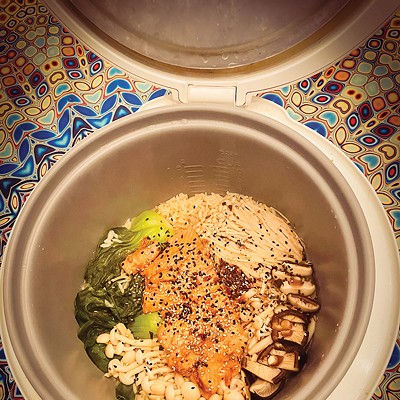Good cornbread is humble and simple. Great cornbread is aromatic, toothsome and flavorful. Cornbread is best when baked in a ripping hot cast-iron skillet and served warm while the aromas are at their fullest. Really good cornbread comes from really good cornmeal. Really good cornmeal is made from corn that has been grown organically, still has the bran and germ left in it (which makes it way more flavorful), and has been kept refrigerated. The finest cornmeal comes from heirloom corn varietals that have been rescued from near extinction.
In the realm of endangered species, animals garner the most attention. However, many once-prolific plant varieties have also faced extinction. Fortunately, individuals like heritage grain revivalist Glenn Roberts of Anson Mills in South Carolina, and Chef Sean Brock of Audrey Restaurant in Nashville have dedicated themselves to rescuing nearly extinct grain varieties. Thanks to their efforts, we can now re-create heirloom recipes with ingredients that taste the way they did before the industrialization of agriculture and the transition to monocropping. This resurrection of heritage grains gives us a unique opportunity to explore flavors and textures that have been lost for generations. By repatriating these heirloom grains, we enrich our culinary experiences and contribute to preserving biodiversity and sustainable agriculture.
Have you ever been disappointed when you've tried to re-create an old family recipe and it didn't taste as good as you remembered it? Heritage recipes are culinary treasures that have been passed down through generations. However, it can be difficult to re-create these recipes accurately because today's ingredients are often not the same as the ones that were used in the past. Cornbread is a good example. Cornbread is a traditional Southern food that can't be experienced in its original form because today's cornmeal isn't the same as the cornmeal of yesteryear. The more flavorful corn varieties of the past have been replaced by less flavorful, but more prolific varieties. The milling process is also different, which affects the texture and baking properties. Corn used to be ground into cornmeal by water-powered millstones. By 1900, stone-ground cornmeal was replaced by cornmeal ground with cylindrical steel rollers. Unlike stone milling, steel roller milling eliminates most of the bran and germ. This prolongs shelf life, but it's at the expense of flavor, aroma and nutrition.
Corn that was to be sent to the stone mill to be ground for cornmeal was left to ripen longer in the field, leading to a higher natural sugar content. Corn destined for a roller mill had to be picked less ripe, resulting in a lower sugar content. The heat produced by steel rollers also degraded the corn, which further reduced its natural sweetness and flavor. This led to the practice of adding sugar to offset the reduction in sweetness.
The best cornbread I've ever had is the version they serve at Sean Brock's Audrey Restaurant in Nashville. It is made from Jimmy Red Corn, a varietal that was rescued from extinction. Jimmy Red was an old bootlegger's corn that made spectacular whiskey. Its ears are bright red, with a richer and sweeter flavor than other varieties. Jimmy Red corn nearly went extinct in the early 2000s following the death of the last known bootlegger known to grow it. Two ears were rescued by a local farmer and seed saver who began growing it and saving seeds each year to increase his seed stock. Chef Brock was able to obtain a few ears and started growing it himself. For Brock: "Jimmy Red harvest time was a celebration and I couldn't get the meal into a cornbread batter and skillet fast enough. Tearing into my first piece of cornbread, the aroma and flavor took me right back to my grandmother's table. I'd never tasted such perfect cornbread in my entire life."
Brock later partnered with Marsh Hen Mill in South Carolina to make Jimmy Red cornmeal commercially available. Marsh Hen mills their products in a restored 1945 mill and separator. In addition to Jimmy Red cornmeal, Marsh Hen also sells Sean Brock Jimmy Red Cornbread Mix. Because the stone milling process doesn't remove all the bran and germ, it is best stored in the refrigerator or freezer to keep it from becoming rancid. You won't find these products in your local grocery store. If you are ever in Nashville, you can find them at Sean Brock's restaurants Audrey and Joyland, or you can order online from Marsh Hen Mill.
For buying cornmeal locally, I recommend Bob's Red Mill Coarse Grind Cornmeal. Bob's Red Mill uses slow-turning quartz-stone mills which maintain cooler temperatures to prevent heat degradation. This process also leaves in the germ and bran.
Traditional Southern cornbread
Unlike most Northern cornbreads, this cornbread does not have added sugar. All the sweetness comes from the corn itself, so it's worth seeking out the best-quality stone-ground cornmeal.
Makes one 10-inch round loaf
Ingredients:
2 cups coarse cornmeal
1 ½ teaspoons kosher salt
½ teaspoon baking soda
½ teaspoon baking powder
1 ½ cups full-fat buttermilk
1 large egg, lightly beaten
¼ cup plus 1 tablespoon lard or bacon fat, melted
Preparation:
Preheat the oven to 450 F. Put a 10-inch cast-iron skillet in the oven to preheat for at least 10 minutes.
Combine the cornmeal, salt, baking soda and baking powder in a medium bowl. Combine the buttermilk, egg and ¼ cup of the melted lard in a small bowl. Stir the wet ingredients into the dry ingredients just to combine; do not overmix.
Carefully move the skillet from the oven to the stove, turning your burner to high heat. Add the remaining tablespoon of melted lard or bacon fat and swirl to coat the skillet. Pour in the batter, distributing it evenly. It should sizzle.
Transfer the skillet back to the oven and bake the cornbread for about 15 to 20 minutes, until a toothpick inserted in the center comes out clean. Serve warm, directly from the skillet.



















